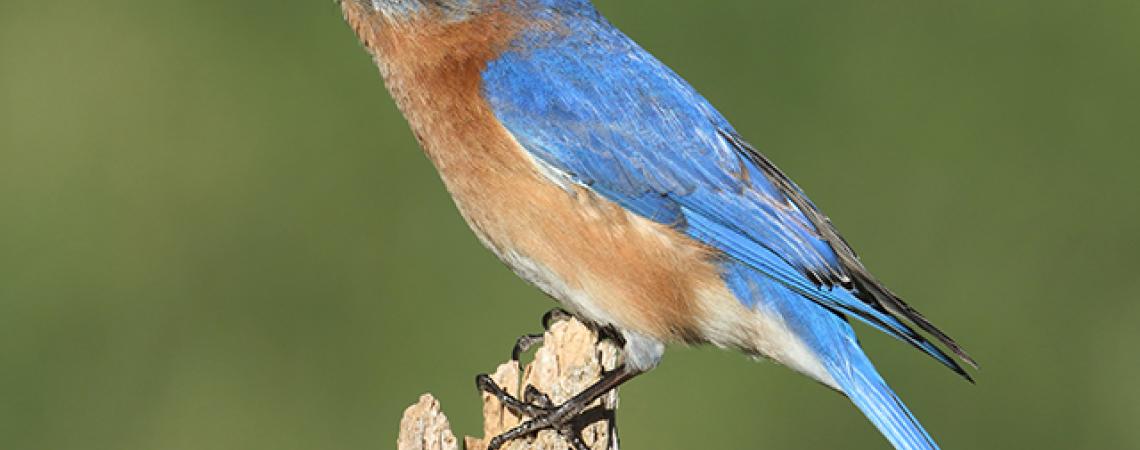Credit: Getty Images
According to an old Pima Indian legend, a flock of very ordinary gray birds became concerned about how unattractive they looked. They began bathing in a sparkling blue mountain lake every morning hoping to make themselves more beautiful. After bathing in the lake for four days, their feathers fell off, and all that remained was gray skin that was even uglier than their plain-looking gray feathers. On the fifth day the feathers grew back in, but this time they were the brilliant blue color of the mountain lake.
Since those days of early American settlers and Indians, the bluebird population has significantly declined. The bluebird was a symbol of hope for those early settlers, and it has now become a symbol of hope for conservation efforts across the country. The comeback of the bluebird is a genuine success story.
A combination of unfortunate events led to the bluebird population’s decline. Some experts estimate that the population of Eastern bluebirds decreased by as much as 75 percent from the late 1800s until the early 1970s, at which time a movement led by Lawrence Zeleny and the North American Bluebird Society (NABS) helped re-establish the habitats for the birds. Bluebirds are cavity dwellers, and, like many other native species, their numbers decreased in proportion to the decrease of natural cavities in which they could nest.
Metal fence posts replaced the wooden ones bluebirds frequently used for nesting.
Trees that might have been used for nesting purposes were cleared to make way for houses and businesses. The house sparrow took over many of the nesting places that bluebirds would have occupied, and the mild-mannered bluebirds were no match for the much more aggressive house sparrows. Add a lethal dose of pesticides and competition with other species for remaining nesting cavities to the mix, and it is no surprise that bluebirds narrowly escaped becoming an addition to the endangered species list.
Supported by the NABS, as well as many individual state bluebird organizations, a movement began to protect and increase the numbers of bluebirds. By building trails of nestboxes and monitoring them faithfully, bird lovers have facilitated the resurgence of this extraordinary species. A trail may consist of anywhere from five to 500 boxes. Trail monitors establish trails in habitats likely to attract bluebirds.
Prime places for nestboxes are city and state parks, golf courses, and farmlands. As I created my own trail, I encountered many disasters before I learned that proper placement of a nestbox can be the difference between life and death for the bluebirds. When I started my trail more than 25 years ago, the wisdom of the time was to place the nestbox near a tree or fence so the fledglings would have someplace close to fly to when first leaving the nest. House wrens would enter the nest, peck holes in the eggs, and kill the nestlings. They would then build a nest of twigs on top of the bluebird nest, ensuring that the bluebird would not be able to return to nest in the box again.
That was the result of placing the nestboxes too close to a wooded area. Placing the boxes in an open area is now the accepted practice, and since I have relocated my boxes at least 100 feet away from trees and thickets, I have found the number taken over by house wrens has dwindled considerably. I also lost many eggs and babies to predators such as raccoons and snakes before I learned to grease the poles the nestboxes were mounted on to make it more difficult for the predators to reach the nest. It was excruciating to check a box that had five eggs in it a few days earlier, and find the nest empty, or worse, filled with ants that had been attracted to the broken eggs. During those early years, I often wondered if I were doing more harm than good. My education was at the price of a number of bluebird eggs not hatching. As I researched and adapted my trail, things begin to get better. I have fledged more than 200 bluebirds from my small nestbox trail.
To encourage continued nesting, I provide mealworms daily to the bluebirds that live here. They come to the feeder when I whistle for them and reward me by staying and nesting on my farm. In the summer a bluebird’s diet consists mainly of insects. As the weather gets colder and insects less plentiful, bluebirds may need to supplement their diets with berries. During the winter months, some bluebirders provide a feed made of peanut hearts, cornmeal, flour, and peanut butter.
I consider it both a privilege and a responsibility to have bluebirds nesting in my boxes and coming to my feeder. As they were for the pioneers before me, they are my symbol of hope.
Bluebird Resources
The North American Bluebird Society provides information on attracting bluebirds, building nestboxes, and other information related to bluebirds.
The Ohio Bluebird Society is the state affiliate of the North American Bluebird Society.
A word of caution: If you decide to try to attract bluebirds to your yard, you must be responsible and provide nestboxes of the proper dimensions and placements. Otherwise, you are asking for disaster. Please do some research at the above websites before putting out nestboxes.
Debbie Steinhausser is a member of South Central Power from Stoutsville.









